| Tylototriton kweichowensis | |||||||||||
| Kweichow Knobby Newt | |||||||||||
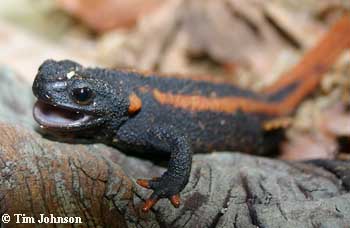
|
|
||||||||||
Description
Tylototriton kweichowensis have a base color of brown to black, and most individuals have three broad orange stripes running the length of the body. The stripe down the center-line is clearly delineated, while the two stripes along the sides are often bumpy or less-defined in appearance. The parotoid glands, tail, and toe tips are usually orange. These newts are relatively large. Mature adults have been documented at 6 - 8 inches (15 - 21 cm) total length, but most captive-raised animals are on the lower end of this range. Their body shape is robust; both males and females look "hefty" compared to other varieties of newts. Females are typically slightly larger than males, both in length and girth.
T. kweichowensis are similar in appearance to several other species of crocodile newts that are kept in captive populations, specifically T. verrucosus, T. shanjing, and T. yangi. Photos here, and on AmphibiaWeb, show the differences in appearance fairly clearly.
Wild populations of these newts occur over a large geographic region. As a result, there can be differences in appearance from one population to the next. Unless you know the original locality of the newts you have, you may not even be certain of the species ID. Some of the captive newts that were previously considered variants of T. kweichowensis have been reclassified as T. yangi.
Natural Range and Habitat
The range of T. kweichowensis includes western Guizhou and northeastern Yunnan provinces of China, at 4500-7900 feet (1400-2400 m) elevation.
In the wild, T. kweichowensis lives on land during most of the year, taking to water mainly during the breeding season. These newts have been found in ponds and slow-flowing streams, usually in places with aquatic vegetation and water depth less than 3 feet (1 meter). They are also found in terrestrial habitats, typically in locations with a lot of moisture, vegetation, and hiding places.
Additional extensive details about this species' wild habitat have been published, and an excellent summary and bibliography can be read online in the Hernandez Account in AmphibiaWeb. We strongly encourage anyone keeping or breeding this species to read that account carefully.
Housing
In my experience, an important requirement in housing adult T. kweichowensis is that they need a large enclosure. The reasons for this requirement are: (1) they are large newts, (2) they need a substantial land area, large enough to move around and have enough hiding places for each animal, and (3) they need a water area that is sufficiently large for breeding activity, and (4) the tank needs to have enough water volume to be filtered and easily maintained with good water quality. For a group of 2 to 3 adults, I recommend a tank with a bare minimum size of 36 x 12 inches (90 x 30 cm) and designed to be roughly 50:50 land:water. I recommend having live plants, both on land and in the water.
During most of the year, most T. kweichowensis stay primarily on the land portion of their tank. There may be a few individuals that spend time in water throughout the year. Their housing should give them the full range of options, with comfortable resting areas in both terrestrial and aquatic areas.
Drowning is a significant risk for all of the terrestrial Tylototriton, and this must be taken into consideration in their housing. The enclosure must provide easy access from water onto land. I lost an adult T. kweichowensis to drowning under a pot in the aquatic part of their tank; I believe she became trapped and not smart enough to find the way out. The design was one that I’ve used with many other newt species, but Tylototriton are clumsy.
T. kweichowensis do well at typical household temperatures. In summer, they can be kept in the mid-70s°F (23-26°C), and in winter they can be kept at 50-65°F (15-20°C). Like most newts, having a difference between summer and winter temperatures will help to prepare them for breeding.
Juveniles are fully terrestrial, and should be housed in a moist (not wet) terrarium environment. A shallow water area may be provided as part of the setup, but the majority of space should be terrestrial. The terrarium can have a soil-based substrate, or paper toweling can be used.
Feeding
Adult Tylototriton in captivity are typically fed chopped nightcrawlers, crickets, and other suitably-sized prey. They have a particular fondness for waxworms and other grubs, but waxworms should not be their primary staple food. They need to eat relatively frequently. A routine of feeding once every 2 days works well and keeps them well-nourished for breeding.
Hand feeding is the best way to ensure that each individual is eating. They are slow-moving animals, so it may be necessary to hold their food in front of them and wait many seconds for them to take it. Some individuals are more shy than others, and may require even more patience to feed by hand. If the animals are allowed to "free-feed" (as opposed to hand-fed), all individuals should be carefully observed to ensure that all are eating well. The shy individuals are at risk of going hungry if the group is allowed to self-feed, with the quicker individuals eating more quickly. In some cases, it may be necessary to separate shy individuals to ensure that they get enough to eat.
In a terrestrial setup, pieces of wiggling worm can be placed on a paper towel for feeding.
At metamorphosis, juveniles are relatively large and can eat pinhead crickets, or be hand-fed with chopped worms. Training them to hand-feed requires patience, but is certainly possible and recommended. As they grow, they can take progressively larger crickets, chopped earthworms, and small grubs, such as fly maggots.
Breeding
Some of the important factors in encouraging breeding in captivity are:
- A large enclosure with adequate land and water areas, and vegetation at the water line for egg laying.
- Ample feeding all year round. It's not enough to feed extra just before/during the breeding season, they need to have ample nutrition all year round in order to produce eggs.
- Temperature. They should experience some fluctuation of temperature between winter and summer.
- Light. It is possible (thought not known for certain) that newts may know when it's time to lay eggs based on the length of daylight, or the change in daylight length with the seasons.
The sexes of adults can be distinguished the same as for other Tylototriton. The male has a slit-shaped cloacal opening, while the female has a round, conical cloaca. In juveniles, the sexes can usually be determined by about 1 year of age. If it isn't obvious from an external view, the cloaca can be gently pulled open to show either a slit-shaped or round opening. See photos in the Sexing Caudates article.
The breeding season of T. kweichowensis has been reported to be May through July (Tian 1998). In my experience, egg laying has occurred between March and June. Some keepers report that a large water change in the spring or early summer will elicit breeding, but I have not noticed any effect of water changes.
Nuptial activity consists of the animals circling each other face-to-face in the water. At some point, the male deposits a spermatophore, and the female picks it up with her cloaca. If courtship or spermatophores are observed in the tank, there is a good chance that eggs will be laid within a few days.
The female will lay one large batch of eggs per year, all produced within a period of about 1 to 3 days. A single clutch of eggs may include 100 or more eggs (Tian 1998). In my experience, about 50 - 150 eggs were produced in a clutch, and the hatch rate varied a lot, from 50-80%. Eggs are preferentially laid at the margin between the land and water, often on vegetation just above the water line. It is important to promptly remove the eggs from the adult enclosure and place them fully in water, as they will dry out if they are left above the water line. The eggs do not stick very tightly, and can be gently removed from vegetation or substrate using fingers, or a small spoon. Some eggs are laid in (or fall into) the water, and these can be removed easily by scooping them up.
Eggs and larvae are cared for using standard methods for Raising Newt and Salamander Eggs. Once the larvae approach 1 inch (2.5 cm), they need to be provided with quite substantial amounts of food. They are larger than the larvae of most other types of newts, and their growth rate is surprisingly rapid. At this stage it is fairly easy to wean them from live food to non-live food, such as frozen bloodworms and finely-chopped earthworms. Underfeeding the larvae can result in floating, and within a couple of days with insufficient food they may be unable to recover. Large water changes are needed to keep the water clean, due to the size and metabolic activity of the animals.
I found that larvae of this species have huge differences in size between the largest and smallest individuals. The smallest ones, even if separated and fed well, did poorly and died before or after metamorphosis. I don't know if this tendency to produce runts is a genetic weakness in the specific bloodline of animals that I have, or if it is a general feature of this species.
References and Additional Information
AMNH Amphibian Species of the World 6.1, an Online Reference. Accessed June 27, 2021. https://amphibiansoftheworld.amnh.org/Amphibia/Caudata/Salamandridae/Pleurodelinae/Tylototriton/Tylototriton-kweichowensis
AmphibiaWeb:
Tylototriton kweichowensis
Herndez account:
Tylototriton kweichowensis
CalPhotos of Tylototriton kweichowensis
IUCN Red List: Tylototriton kweichowensis
Nussbaum & Brodie 1982.
Partitioning of the Salamandrid Genus Tylototriton Anderson (Amphibia: Caudata) with a Description of a New Genus.
Herpetologica Vol. 38, No. 2 (Jun., 1982), pp. 320-332.
https://www.jstor.org/stable/pdf/3892334
Tian Yingzhou, Sun Aiqun, Li Song. Studies on reproductive ecology of Tylototriton kweichowensis Fang and Chang Sichuan Dong wu = Sichuan Dongwu = Sichuan Journal of Zoology. 1998 ;17(2):60-64. https://europepmc.org/article/cba/312339
Ziegler, T., Hartmann, T., Van der Straeten, K., Karbe, D., and Böhme, W. (2008). ''Captive breeding and larval morphology of Tylototriton shanjing Nussbaum, Brodie & Yang, 1995, with an updated key of the genus Tylototriton (Amphibia: Salamandridae).'' Der Zoologische Garten, 77, 246-260. https://doi.org/10.1016/j.zoolgart.2008.01.001
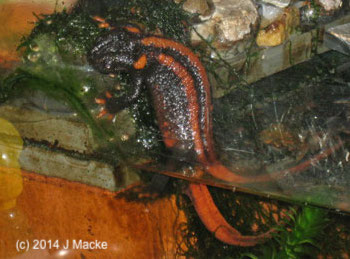 Female T. kweichowensis in the process of laying eggs. |
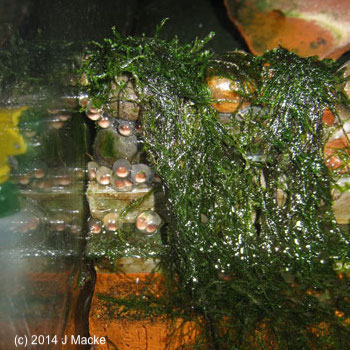 Eggs just after being deposited. Most of the eggs are above the water line. Many are not visible in the photo, as they are tucked under the java moss. |
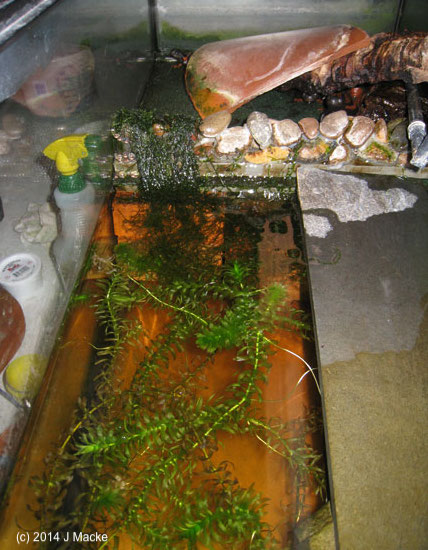 A fairly simple setup used for breeding. It has a 50/50 split of land/water areas. |
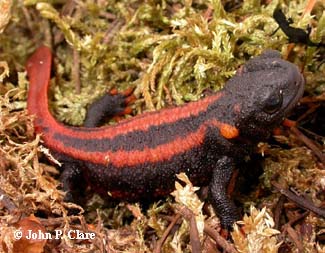 |
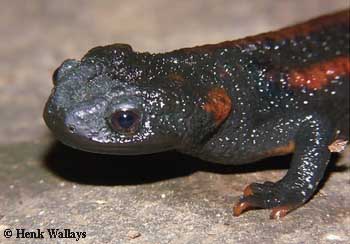 |
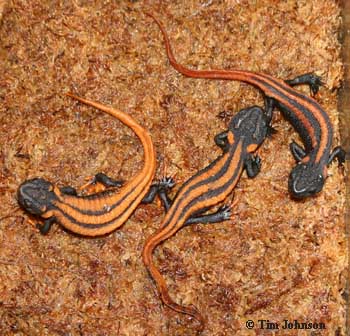 |
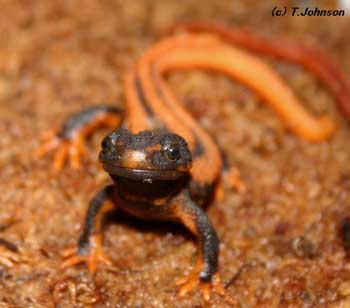 |

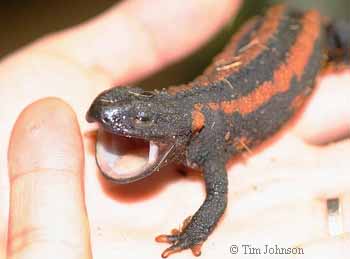 |
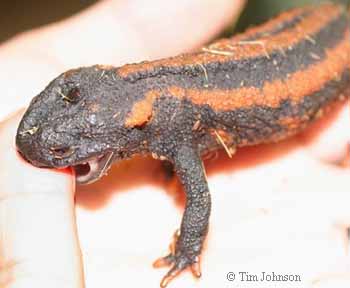 |
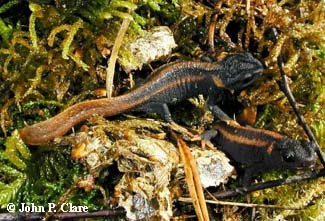
|

|
 |
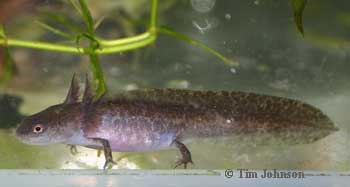 |
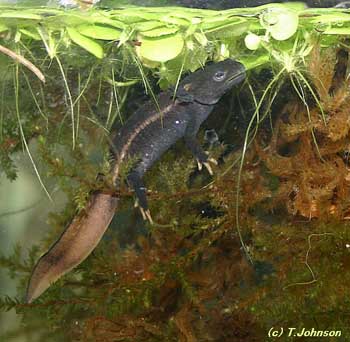 |
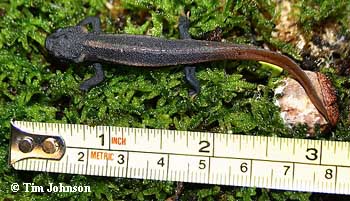 |
© 2021 Jennifer Macke. Posted July 2021.
